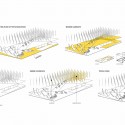
Courtesy of Stockholm Field Office
The shortlisted proposal for the Swedish Pavilion at the upcoming 2012 World Expo by Stockholm Field Office, in collaboration with Fieldwork, is based on the idea of gradients; the gradual shifts in Swedish landscape and relatively smooth changes in Swedish society. This idea is interpreted into different spatial elements, gradually fading between different points in space. They create the physical environment of the exhibition space, showcasing information and objects as well as guiding the flows of visitors through the space. More images and architects’ description after the break.
The national pavilions of the upcoming 2012 World Expo will be housed in structures provided by the Yeosu 2012 Organizing Organization. At the start of the design competition, the actual space of the Swedish pavilion had not yet been selected. Thus, the precondition for the design was to create an interior design concept, applicable within a number of different spaces of similar size, but different in shape and form, and to connect to the over all theme of the 2012 Expo; “The Living Ocean and Coast”.
Gradients
The Swedish landscape provides an evocative point of departure for the design of the Swedish pavilion at ʻExpo Yeosu 2012ʼ. Sweden possesses a landscape characterized by slow and gradual change. Plains and farmland in the south are replaced by hills and forests as you travel north. The hills become mountains, and the forests give way to brushwood and heather as they are pushed towards the sky. Along the coasts, land dissolves into the sea, forming archipelagos of islands to which the urban fabric of adjacent cities is inevitably drawn. Cities grow towards the water, forming dense fringes that give way to a landscape dotted with summerhouses and boat masts.
The experience of the Swedish landscape as a gradient, characterized by gradual shifts in character, also provides a fitting metaphor for the experience of Swedish culture. Change in Swedish society has been gradual: there have been no revolutions, and the journey from peasant society to an industrialized country and then towards a service-based knowledge economy has progressed with surprisingly little drama.
Spatial Elements
The experience of the ʻgradientʼ in the Swedish landscape and culture provides the conceptual backbone for the design of the Swedish pavilion at Expo Yeosu 2012. The architectural space of the pavilion is produced by a series of distinct spatial elements, which interpret the gradients found in Swedish ʻnatureʼ and support the various functions of the pavilion. A wooden landscape facilitates movement across its angled surface. It produces a publically-accessible “visitors loop” that connects the different parts of the exhibition.
The general exhibition material, as well as the specific presentations of exhibiting companies, can be displayed on multiple surfaces: both on wooden rocks rising from the ground and on a forest of suspended linen sheets. The surrounding walls of the space can also be used to carry visual information and podium structures can be utilized to display physical exhibition objects. Above the space, linen sheets hang in a cloud-like formation. Wooden islands create an archipelago of seats for resting or conversation, as well as a reception desk, café and shop.
Underground, below the surface of the landscape, back-office functions, conference rooms and an auditorium are contained within caves – volumes made of stretched textile that can be reconfigured in accordance with shifting needs and program.
Second Stage Treatment
During the second stage of the competition, a specific space had been chosen. Adjustments to the design was made, in order to fit the updated program requirements within the specific space. Updates relating to accessibility and updated communication strategy was produced as well.


























Swedish Pavilion Proposal / Stockholm Field Office originally appeared on ArchDaily, the most visited architecture website on 25 Feb 2012.
send to Twitter | Share on Facebook | What do you think about this?






